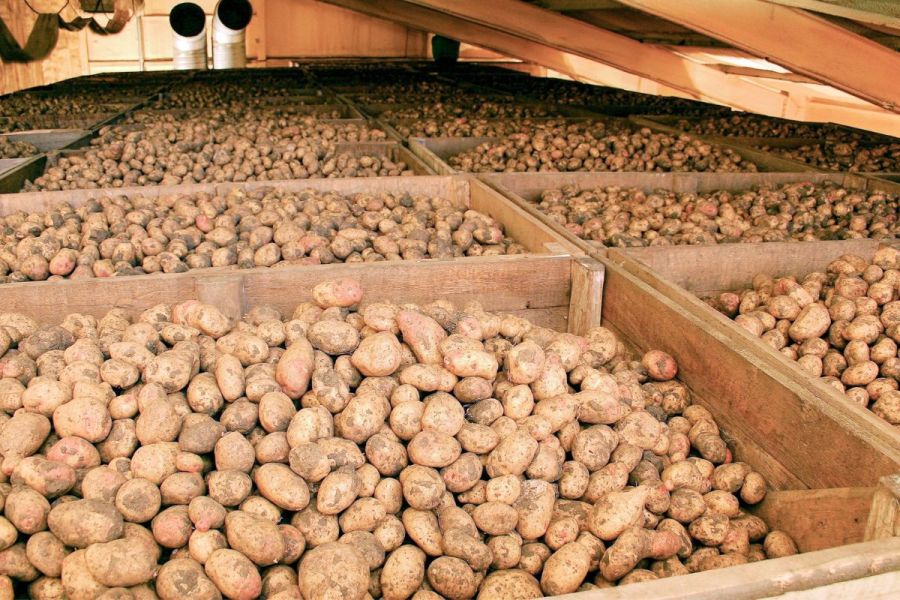Is there much more left to say on potato storage and life after CIPC? CPM speaks to recent industry award winner, Adrian Cunnington, to find out his thoughts on what could happen next.
“Short-term wobbles and changes in the landscape don’t undermine the requirement for a year-round supply of potatoes.”
By Janine Adamson
It’s important to give credit where its due, even if the recipient is a little coy about accepting the compliment. However, for those in the know, it’ll come as no shock that Adrian Cunnington found his recent award presentation a little surprising.
He was bestowed the British Potato Industry Award – regarded as the crème-de-la-crème of accolades – acknowledgment of an outstanding contribution to the potato sector and a lifetime’s achievement. Previous winners include Gordon Smillie, Ian Toth and David Firman.
According to Adrian, receiving such a commendation was much welcomed, but wholly unexpected. For one, he’s an expert in the world of potato storage, a topic which he admits is rare to hit the mainstream headlines.
But one occasion in which it did attract wider attention was following the loss of chlorpropham (CIPC) in 2020. Reflecting back, he says although there have been some unsteady moments within storage circles since, on the whole, great progress has been made.
“A lot of change took place in a short space of time but the main challenge was how to control potato sprouting in-store with a nearly new toolbox.
“Although maleic hydrazide wasn’t new, it found itself under the spotlight – within months we went from around 20% of UK potatoes being treated with MH to 70%,” he explains. “Whereas for other options such as the oils [spearmint and orange], it’s taken around three years to understand their use, either alone or in combination for sprout control on processing crops. Really, we’ve been learning on the job.”
For growers as well as industry experts, Adrian believes it’s been a steady learning curve which can undoubtedly prove daunting. However, he says there was no choice but to find a way forward. “Sadly, there have been some casualties along the way, but on the whole it’s a positive story.”
With new options on the table including 1,4-Dimethylnaphthalene (DMN), Adrian says the ‘big players’ have since established clear preferences which could have an impact when it comes to switching contracts or end markets.
“McCain has aligned with ethylene which of all the options, is most unique in its management. This is because it appears to affect fry colour, so requires additional action during processing. PepsiCo and Lamb Weston have opted for a combination of DMN and oils.
“Importantly, all processors seem to support the importance of MH in offering baseline residual control,” he says.
And Adrian finds himself at the centre of such discussions mainly because he offers a wealth of experience on the topic – more than 30 years of dedication in fact. During this time he headed AHDB’s Sutton Bridge Crop Storage Research centre, a facility which many mourned the loss of following its closure in 2021.
He’s also been, and remains, involved in a wide range of industry activities from R&D to on-farm troubleshooting; he even authored the potato store manager’s guide. So, with that in mind, many would argue his voice should cut through when it comes to the future of potato storage.
“It might sound a little political, but a lot of time has been spent supporting growers and their stores yet it’s apparent that margins during the past 5-10 years simply don’t support investment in new facilities.
“Stores are ageing and past their sell-by-date which makes it difficult to achieve market quality at an affordable price. Running costs have escalated – new products cost £3-5/t more than CIPC. Storage costs in total are now £10-15/t more than in 2015m,” stresses Adrian, who now runs his own consultancy under the name Potato Storage Insight.
As stores degrade and become unfit for purpose, he believes rather than be replaced, they’ll cease to exist all together. “To put it bluntly, the whole industry is in a depression and we have to get out of it to avoid even more growers abandoning potatoes.
“Then it becomes a food security issue. Short-term wobbles and changes in the landscape don’t undermine the requirement for a year-round supply of potatoes,” he says.
So, is there a solution? For Adrian, a start would be the provision of small capital grants which ‘pump prime’ and encourage investment in storage infrastructure. Then, it comes down to demonstrating further support of those striving to fill the gap left behind by AHDB potatoes.
“We don’t have the same core representation across the industry which we did have. Many individuals, companies and voluntary bodies, such as GB Potatoes, are coming together to address this which will hopefully solidify as time progresses.”
Bringing it back to his core expertise, which is technical potato storage insight, Adrian believes there remains scope to progress.
“Technically, we have to keep working on more dormant varieties which can be stored at higher temperatures to reduce the electricity burden. Plus there’s huge opportunity within novel storage management techniques and agri-tech.
“At the moment, the way stores are managed is quite naïve when you compare it with other areas of crop production; we don’t always do things in the smartest of ways. Instead, energy and inputs have to be conserved for something that’ll be effective,” explains Adrian.
“A prime example is precision treatment – what an opportunity? But of course this cycles back to the issue of cash-flow and investment. The development and subsequent roll-out of such solutions comes at a cost and where will that come from?” he questions, to conclude.
This article was taken from the latest issue of CPM. Read the article in full here.
For more articles like this, subscribe here.
Sign up for Crop Production Magazine’s FREE e-newsletter here.




